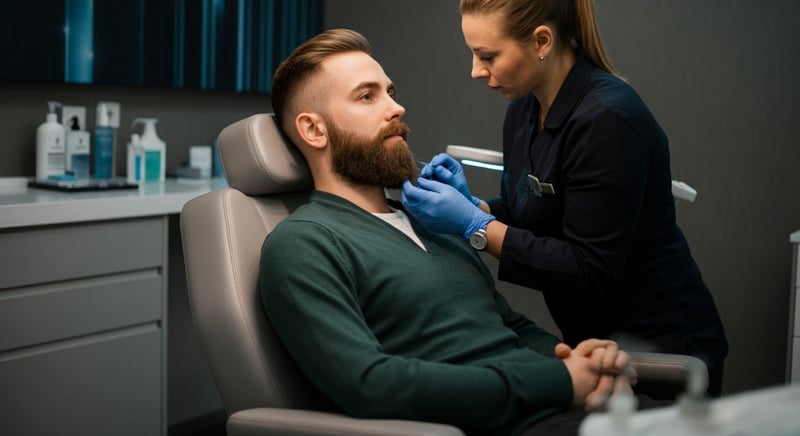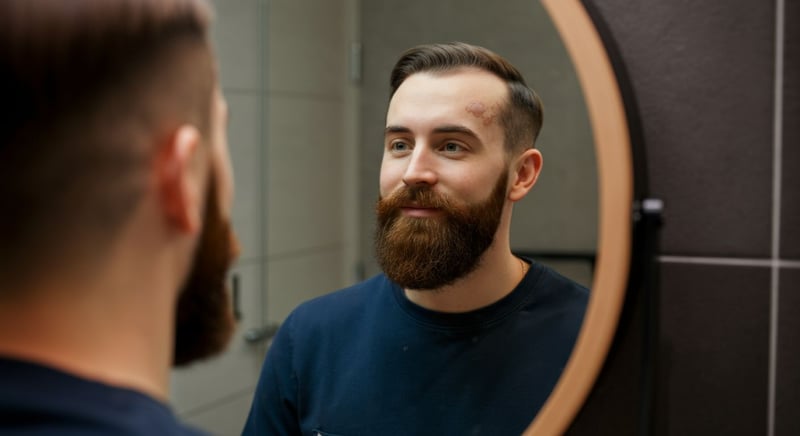Crafting Confidence: Your Guide to Beard Restoration
Explore innovative beard restoration techniques to achieve the beard of your dreams.
Facial hair has long been a sign of masculinity, maturity, and sophistication. For those struggling with uneven growth or a patchy beard, beard restoration offers a lifeline. With the advancements in cosmetic procedures, a beard transplant can transform facial aesthetics and boost self-esteem. This guide explores all facets of beard restoration, from assessing if the procedure suits you to understanding the recovery phase.
Join us as we delve into the world of facial hair restoration, shedding light on innovative techniques and life-changing transformations.
Unlocking Facial Hair Growth: Is a Beard Transplant Right for You?
Determining Factors for a Beard Transplant
Deciding if a beard transplant is right involves assessing several key aspects. The primary reasons behind wanting a fuller beard play a significant role. For some, it may be due to genetic factors that limit natural facial hair growth. Others might experience hair thinning because of hormonal imbalances. Medical conditions or treatments can also impact beard density.
A pivotal step is consulting with a skilled beard surgeon. This expert evaluates the current state of your facial hair, examines the health of your skin, and pinpoints potential donor areas for hair follicles. The aim is to provide personalized guidance on whether a facial hair transplant aligns with your facial structure and desired results. Patients also should consider their expectations.
Emotional and Personal Considerations
Beyond the medical and technical evaluations, patients should explore the emotional and personal motivations driving their interest in a beard transplant. Desiring a more robust beard can stem from a quest to enhance confidence, align with personal aesthetic goals, or fulfill cultural or social expectations. Understanding these drivers helps ensure satisfaction.
- Personal Image: Consider how enhanced facial hair resonates with your self-perception. For example, if a stronger beard supports your identity, a transplant might provide significant personal satisfaction.
- Social Factors: Assess the external pressures or norms influencing your desire for a fuller beard. For instance, if professional or social settings value robust facial hair, a transplant could assist in meeting these expectations.
- Emotional Well-being: Reflect on the potential impact on your self-esteem and emotional state. For example, if a fuller beard boosts your confidence.
A facial hair transplant candidate must carefully consider the emotional aspects, as these can significantly influence their overall happiness.

Follicular Unit Extraction Beard: Demystifying the Procedure
Understanding the FUE Technique for Beard Transplants
Follicular Unit Extraction (FUE) is a method used in facial hair transplants. It carefully harvests individual hair follicles from areas with denser hair, typically the back of the scalp. These follicles are then implanted into the beard area. This technique is valued for creating natural-looking growth patterns with minimal scarring. The success of this method comes from its precision, providing a ongoing solution with a quick recovery.
Before undergoing the procedure, individuals need to understand the length of the procedure, exact techniques, and expected results. For example, a person looking to fill patchy areas might achieve a fuller, more uniform beard that significantly enhances their facial aesthetics.
Key Considerations Before Undergoing FUE
When considering FUE for a beard transplant, several factors should be taken into account to ensure optimal outcomes and satisfaction.
- Realistic Expectations: Understand that the density achieved might vary based on individual hair characteristics and the availability of donor hair. For example, someone with fine hair might require more follicles for similar density compared to someone with coarse hair.
- Surgeon Expertise: Select a surgeon experienced in FUE techniques for facial hair. An experienced professional can tailor the implantation to match natural growth patterns.
- Post-operative Care: Be prepared to follow a strict post-op care regimen. This includes avoiding strenuous activities and protecting the transplanted area. Proper care ensures the survival of the newly implanted follicles.
Knowing these aspects helps ensure the beard restoration process aligns with expectations. According to experts, meticulous planning and skilled execution are critical for a successful FUE facial hair transplant.
- Donor Area Assessment: The surgeon must evaluate the donor area to ensure sufficient hair density. They should confirm that extraction will not visibly thin the donor site.
- Hairline Design: Prior to beginning, the surgeon needs to carefully design the new hairline and beard shape. This should complement the patient's facial features.
- Follicle Placement: Each follicle must be placed at the correct angle and depth to mimic natural beard growth. Correct placement is essential for a natural look.

Beard Transplant Before and After: What Results Can You Expect?
Understanding the Transformation Through Before and After Photos
Anyone considering a transplant is eager to explore the beard transplant before and after photos. These photos are critical for setting realistic expectations. They showcase various stages from initial post-op to full growth, highlighting transformations. The journey varies per individual based on hair type and adherence to post-procedural care.
Pondering the value of a beard restoration procedure, weighing confidence gains, can affirm your decision. Clinics often provide galleries, offering a glimpse into potential outcomes.
- Immediate Post-Op: Initial photos show redness. Small scabs are normal. These visuals help manage expectations.
- Three to Four Months: This stage reveals initial growth. Some hairs might shed. The photos illustrate the waiting game.
- Nine Months to a Year: Final results appear. The density and coverage are evident, completing the transformation.
Navigating Expectations for a Facial Hair Transplant
When exploring beard hair implants, setting reasonable expectations is essential. Results from a facial hair transplant depend on factors like hair texture, skin type, and transplant technique. Understanding these elements helps tailor expectations to what's realistically achievable.
- Hair Characteristics: Coarse hair provides more coverage, affecting density. Fine hair gives subtle fullness.
- Skin Elasticity: Supple skin accommodates grafts better, impacting new hair integration. This leads to natural outcomes.
- Follicle Survival: The percentage of grafts that thrive influences beard thickness. This affects overall success.

Beyond the Procedure: Mastering Your Beard Transplant Recovery
Essential Aftercare for a Successful Beard Transplant
Recovery is crucial for the success of your beard transplant. Adhering to specific aftercare guidelines is vital, especially regarding water exposure and physical activities immediately following the operation. Proper care ensures the transplanted follicles establish themselves correctly and promotes healthy beard growth. The initial days post-transplant require meticulous attention to avoid any disturbance to the newly implanted grafts. For example, adjustments to sleeping positions and clothing choices can provide more comfort during your beard restoration.
Following the skincare regimen provided by your surgeon is essential for preventing complications and ensuring optimal healing. This may include gentle cleansing routines and the application of prescribed ointments to minimize infection risks. Individuals who neglect aftercare, risk compromising the outcome of their facial hair transplant.
Managing Expectations and Achieving Satisfaction
A key part of the beard transplant journey is understanding and managing your expectations. Educating yourself about the typical timelines for swelling, shedding, and new hair growth is a must, as this knowledge helps alleviate concerns and ensures you remain patient throughout the process. It’s important to know that initial shedding is a normal part of the hair growth cycle, and final results take time to manifest.
Effective expectation management can significantly enhance satisfaction as you progress towards achieving your desired beard. The gradual transformation from the initial transplant to a fully grown beard is a journey that combines science and patience. For instance, understanding that full density might take several months to achieve helps maintain a positive outlook
- Immediate Post-Op Care: Focus on resting and adhering to the surgeon's specific instructions. For example, use cold compresses to minimize swelling around the treated areas.
- Mid-Term Management: Follow through with all skincare directives for maintaining a healthy environment. This supports optimal growth, ensuring the beard hair implants integrate well into the skin.
- Long-Term Patience: Recognize that beard development takes time. Full results from a facial hair transplant, can take up to a year.
- Hygiene Practices: Regular cleansing helps prevent infection and promotes healing. Using gentle, recommended products is vital.
- Sun Protection: Shielding the transplanted area from direct sunlight is essential. This protects the new grafts and fosters healthy development.
- Routine Check-Ins: Schedule follow-up appointments with your surgeon. These appointments allow for monitoring your progress.
Follicular Unit Extraction (FUE) Delivers Natural-Looking Beard Transplants
estethica leverages Follicular Unit Extraction (FUE) for beard transplants, carefully harvesting individual hair follicles from areas with denser hair, like the back of the scalp, and implanting them into the beard area. This technique is valued for its precision, providing a permanent solution with a quick recovery and creating natural-looking growth patterns with minimal scarring.
estethica's surgeons consult with each patient to evaluate facial hair, examine skin health, and identify donor areas to provide personalized guidance for facial hair transplants. They tailor the implantation to match natural hair growth patterns, ensuring aesthetically pleasing and natural results.
Meticulous Post-Operative Care Ensures Successful Beard Transplant Recovery at estethica
estethica provides comprehensive aftercare guidelines to ensure the correct establishment of transplanted follicles and promote healthy beard growth. Post-operative care includes skincare regimens with gentle cleansing routines and prescribed ointments to minimize infection risks, with adjustments to sleeping positions and clothing choices for added comfort.
estethica educates patients on typical timelines for swelling, shedding, and new hair growth to alleviate concerns and ensure patience throughout the beard transplant process. The gradual transformation from the initial transplant to a fully grown beard demonstrates estethica's commitment to combining science and patience for optimal results.
Frequently Asked Questions
Is a beard transplant permanent?
What results can I realistically expect from beard transplant before and after photos?
What is the recovery process like after a facial hair transplant?
How does follicular unit extraction beard technique work?
Achieve your aesthetic goals with estethica's personalized treatments and expert care.
📞 Book Your Consultation Now!